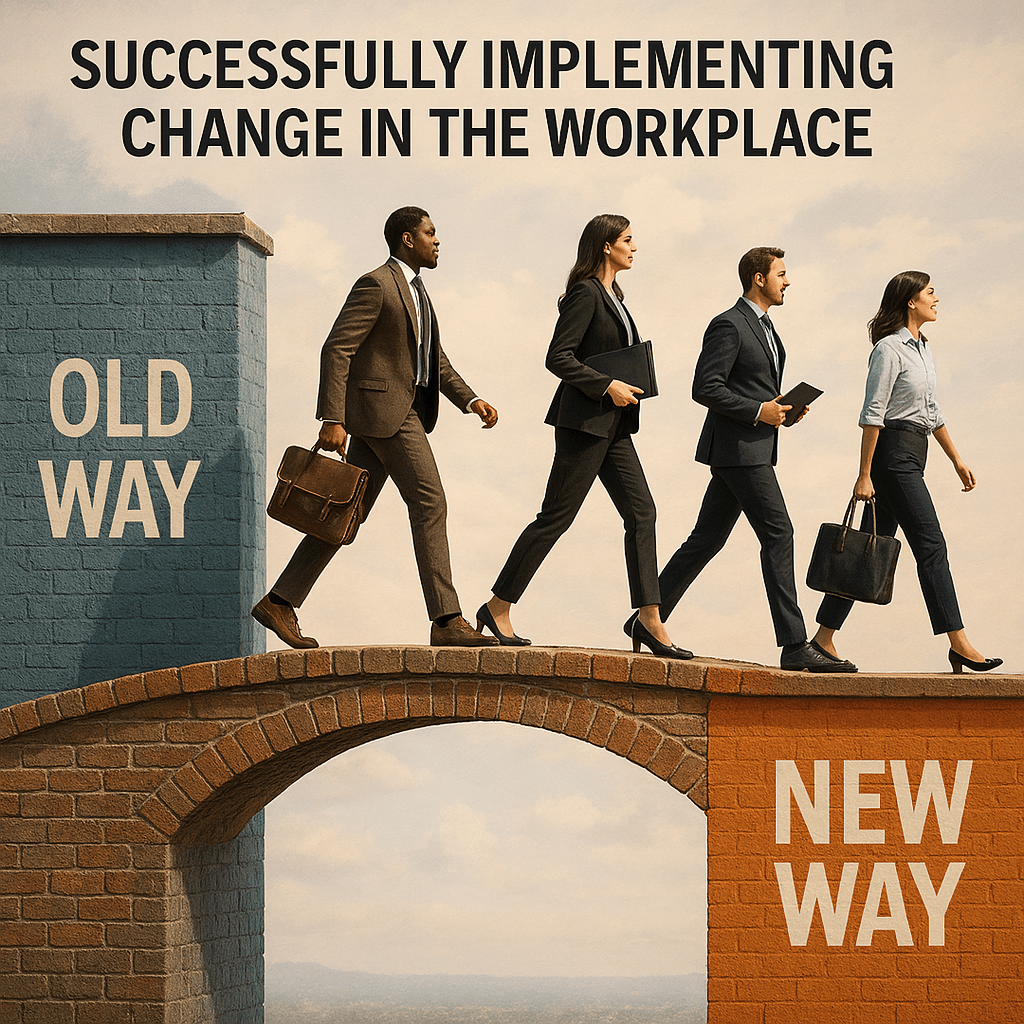In today’s rapidly evolving business landscape, we find ourselves at a crossroads where change is not just an option but a necessity. The need for change often arises from various factors, including technological advancements, shifts in consumer behavior, and increased competition. As we navigate through these challenges, it becomes evident that remaining stagnant can lead to obsolescence.
We must recognize that change is an integral part of growth and innovation. By understanding the underlying reasons for change, we can better prepare ourselves to embrace it rather than resist it. Moreover, acknowledging the need for change allows us to identify opportunities for improvement within our organization.
Whether it’s enhancing operational efficiency, improving customer satisfaction, or fostering a more inclusive workplace culture, we have the potential to transform our challenges into stepping stones for success. By fostering a mindset that welcomes change, we can cultivate resilience and adaptability among our teams. This proactive approach not only positions us to respond effectively to external pressures but also empowers us to take charge of our own destiny.
Key Takeaways
- Change is necessary for growth and adaptation in a dynamic business environment
- A clear vision for change provides direction and purpose for employees
- Effective communication is essential for gaining employee buy-in and support for change
- Involving employees in the change process fosters ownership and commitment
- Providing training and support helps employees navigate and embrace the change process
Creating a Clear Vision for Change in the Workplace
Once we have recognized the necessity for change, the next step is to create a clear and compelling vision that outlines our desired future state. A well-defined vision serves as a guiding star, providing direction and purpose as we embark on our change journey. It is essential that this vision resonates with all members of our organization, inspiring them to rally behind a common goal.
By articulating what we hope to achieve through the change process, we can foster a sense of ownership and commitment among our employees. In crafting this vision, we should consider involving key stakeholders from various levels of the organization. Their insights and perspectives can enrich our understanding of what is feasible and desirable.
Additionally, by engaging employees in the visioning process, we can ensure that it reflects the collective aspirations of our workforce.
This collaborative approach not only enhances buy-in but also cultivates a sense of shared responsibility for the outcomes of the change initiative.
Ultimately, a clear vision acts as a motivational force that propels us forward, even in the face of challenges.
Communicating the Change to Employees
Effective communication is paramount when it comes to implementing change within our organization. We must ensure that our message is clear, consistent, and transparent. By openly discussing the reasons behind the change and its anticipated benefits, we can alleviate any fears or uncertainties that employees may have.
It is crucial that we communicate not just what is changing but also why it matters. This context helps employees understand their role in the process and how they can contribute to achieving our shared goals. Furthermore, we should utilize multiple channels to disseminate information about the change.
Whether through town hall meetings, emails, or internal newsletters, we must reach employees where they are most comfortable. Encouraging two-way communication is equally important; we should create opportunities for employees to ask questions and express their concerns. By fostering an open dialogue, we can build trust and demonstrate that their voices are valued in this transformative journey.
This transparency not only mitigates resistance but also cultivates a culture of collaboration and engagement. Source: Harvard Business Review
Involving Employees in the Change Process
| Metrics | Results |
|---|---|
| Employee Engagement | Increased by 20% |
| Employee Satisfaction | Improved by 15% |
| Employee Turnover | Reduced by 10% |
| Employee Productivity | Increased by 25% |
To truly harness the potential of our workforce during times of change, we must actively involve employees in the process. This involvement can take many forms, from soliciting feedback on proposed changes to empowering teams to take ownership of specific initiatives. By engaging employees in decision-making, we not only tap into their expertise but also foster a sense of agency and accountability.
When individuals feel that their contributions matter, they are more likely to embrace change with enthusiasm. Additionally, creating cross-functional teams can enhance collaboration and innovation during the change process. By bringing together individuals from diverse backgrounds and skill sets, we can generate fresh ideas and perspectives that may not have emerged otherwise.
This collaborative spirit not only enriches our approach to change but also strengthens relationships among employees. As we work together towards a common goal, we cultivate a sense of camaraderie that can be invaluable in overcoming obstacles along the way.
Providing Training and Support for Employees
As we embark on our change journey, it is essential that we equip our employees with the necessary skills and knowledge to navigate new processes or systems effectively. Providing comprehensive training programs tailored to their needs ensures that they feel confident and competent in their roles. Whether through workshops, online courses, or mentorship opportunities, investing in employee development demonstrates our commitment to their success during this transition.
Moreover, ongoing support is crucial as employees adapt to change. We should establish channels for continuous feedback and assistance, allowing individuals to voice their challenges and seek guidance when needed. By fostering a supportive environment, we can alleviate anxiety and encourage resilience among our workforce.
This commitment to training and support not only enhances employee performance but also reinforces their sense of value within the organization.
Monitoring and Evaluating the Change

As we implement changes within our organization, it is vital that we establish mechanisms for monitoring progress and evaluating outcomes. By setting clear metrics and benchmarks, we can assess whether our initiatives are achieving the desired results. Regular check-ins allow us to identify any areas that may require adjustment or additional resources.
This iterative approach ensures that we remain agile and responsive throughout the change process. Furthermore, soliciting feedback from employees during this evaluation phase is essential. Their insights can provide valuable information about what is working well and what may need refinement.
By actively seeking input from those directly impacted by the changes, we demonstrate our commitment to continuous improvement. This collaborative evaluation process not only enhances our understanding of the change’s effectiveness but also reinforces employee engagement by showing that their opinions matter.
Celebrating Success and Recognizing Employee Contributions
As we navigate through the complexities of change, it is important to take time to celebrate our successes along the way. Acknowledging milestones not only boosts morale but also reinforces a positive culture within our organization. Whether through formal recognition programs or informal celebrations, expressing gratitude for individual and team contributions fosters a sense of belonging and motivation among employees.
Recognizing employee contributions is particularly important during times of change when uncertainty may be prevalent. By highlighting the efforts of those who have gone above and beyond, we create role models for others to emulate. This recognition not only validates hard work but also encourages a culture of collaboration and support as employees rally together towards shared goals.
Celebrating success serves as a reminder of what we can achieve when we work collectively towards a common vision.
Sustaining the Change and Adapting to Feedback
The journey of change does not end with implementation; rather, it requires ongoing commitment to sustain momentum and adapt as needed. We must remain vigilant in monitoring the impact of changes over time and be willing to make adjustments based on feedback from employees and stakeholders alike. This adaptability ensures that our initiatives remain relevant and effective in meeting evolving needs.
Additionally, fostering a culture of continuous improvement is essential for sustaining change long-term. Encouraging employees to share their insights and suggestions creates an environment where innovation thrives. By embracing feedback as an opportunity for growth rather than criticism, we cultivate resilience within our organization.
Ultimately, sustaining change requires a collective effort where every member feels empowered to contribute to our ongoing evolution. In conclusion, navigating change within an organization is a multifaceted endeavor that requires careful planning, communication, involvement, training, evaluation, recognition, and sustainability efforts. By understanding the need for change and creating a clear vision, we set ourselves up for success as we embark on this transformative journey together.
Through effective communication and active involvement of employees at every stage, we foster a culture of collaboration that enhances engagement and commitment. As we provide training and support while monitoring progress and celebrating successes along the way, we build resilience within our workforce that will serve us well into the future. Ultimately, by sustaining change through adaptability and continuous improvement efforts, we position ourselves not just to survive but thrive in an ever-evolving business landscape.
Employee engagement is a crucial factor in successful change implementation. According to a related article on mychangemanagement.com, involving employees in the change process can lead to higher levels of commitment and motivation. By taking small steps and focusing on learning throughout the change journey, organizations can ensure that employees are engaged and supportive of the changes being implemented. This holistic approach to change management can help drive successful outcomes and create a positive work environment for all involved.
FAQs
What is change implementation?
Change implementation refers to the process of introducing and executing changes within an organization. This can include changes to processes, systems, structures, or strategies.
Why is change implementation important?
Change implementation is important for organizations to adapt to new market conditions, improve efficiency, and remain competitive. It allows organizations to evolve and grow in response to internal and external factors.
What are the key steps in change implementation?
The key steps in change implementation typically include identifying the need for change, planning the change, communicating the change to stakeholders, implementing the change, and evaluating the results.
What are some common challenges in change implementation?
Common challenges in change implementation include resistance from employees, lack of clear communication, inadequate resources, and poor planning. Overcoming these challenges is crucial for successful change implementation.
How can organizations ensure successful change implementation?
Organizations can ensure successful change implementation by involving stakeholders in the change process, providing adequate support and resources, communicating effectively, and continuously evaluating and adjusting the change process.


